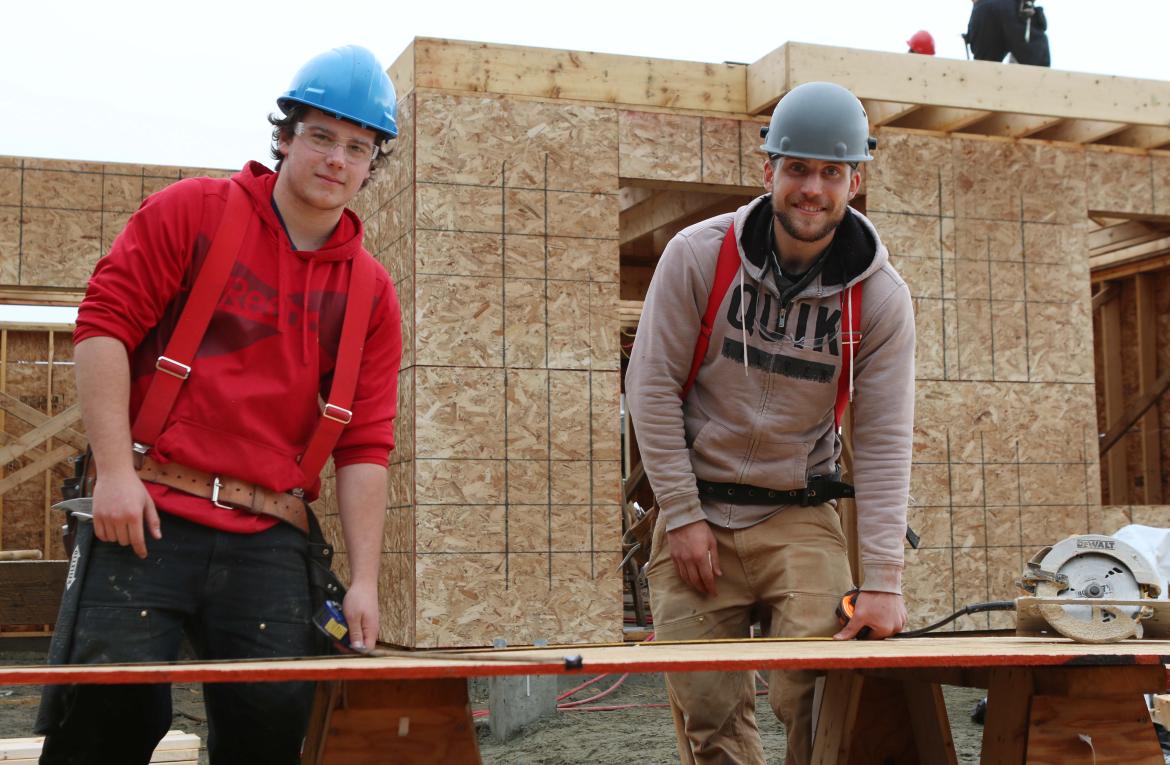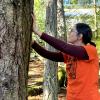
VIU Carpentry Foundation students Reid Della-Rosa, left, and Tyler Norn are experiencing what it’s like on a real job site thanks to a partnership between the University and Habitat for Humanity Mid-Vancouver Island.
April 12, 2017 - 9:15am
The University’s partnership with the non-profit group allows students to experience working on a real job site while helping out families in need
Vancouver Island University (VIU) carpentry students are building a strong foundation for a career in the construction industry, thanks to a partnership between the institution and Habitat for Humanity Mid-Vancouver Island.
Five years ago, the University entered a partnership with the non-profit group that sees VIU students helping to build Habitat homes. In return, the students get to apply some of the skills learned in the classroom to a real-world situation and experience what it’s like on a job site. Habitat for Humanity mobilizes volunteers and community partners to build affordable housing, which is sold with no down payment and an interest-free mortgage to low-income families, who must undergo a rigorous qualification process. The families chosen for the homes partner with Habitat by contributing sweat equity hours.
VIU Carpentry students have worked on eight Habitat for Humanity houses, and students in the Heavy Equipment Operator program have also worked on some of the job sites. This year, students helped with two houses at Habitat’s six-home subdivision off Extension Road in the Cinnabar Valley area. VIU students also worked on the first two houses to be built in the subdivision last year, and plans are to return to help build the remaining two later this year.
VIU Carpentry Foundation student Tyler Norn, 25, was excited to be out building real houses this year. Norn, who decided he wanted a career in the industry after working as a labourer on a construction site in Kamloops, used to walk through houses that had just been framed up and wish he knew how to put them together. The class built the foundations in early December, then came back to the site in the new year to frame up the houses.
“This project gives us a good taste of what it’s really like on a job site,” he says. “I think this is an important part of the course. If we were just in the classroom, we wouldn’t transfer those skills as fast. This is one of those trades where you learn best by making mistakes. When we make mistakes, we are able to problem-solve through it, and then we have the time to correct mistakes without penalty. I’ve watched the whole class get a lot better.”
Students built the first house without air guns to practice their nail-hammering skills. Reid Della-Rosa, a 17-year-old dual credit student from Nanaimo District Secondary School, says inexperience led to a lot of nail-pulling at first.
“It’s night and day, the difference between learning theory in a classroom and then coming out here and doing it,” he says. “There was a sharp learning curve on the first house, but the second one went up a lot faster. You know everyone’s going to survive on real job sites because they’re all working, no one’s sitting around.”
Students in the 8-month Foundation program cover a lot of theory in the classroom before coming out to the Habitat job site, says Carpentry Instructor Mike Braun.
“This partnership adds so much to our program because many people who enter the trades are experiential learners,” he says. “We can talk until we are blue in the face and build little models, but it’s baby steps compared with building full-size structures. They’re so engaged because they know what they are doing now. They understand why they learned all that math in class – it’s all starting to click in place for them.”
When students make mistakes, Braun turns it into a learning opportunity, asking students to analyze what they did wrong and how they are going to fix it.
Jessie Magee-Chalmers, Associate Dean of VIU’s Trades and Applied Technology Faculty, made the connection between VIU and Habitat when he was Chair of the Carpentry department, and he is now on the non-profit’s board of directors and chairs the group’s Build Committee. He calls the partnership “vital” to the success of the VIU Carpentry program because it provides real work experience for students’ resumes.
“The students also have the satisfaction of knowing that their learning opportunities are making a difference in the community,” says Magee-Chalmers. “Both the experiential learning and community engagement aspects of this partnership serve to develop attributes that will help students become valued contributors in their chosen communities.”
Rob Hallam, Executive Director of Habitat for Humanity Mid-Vancouver Island, says the support from VIU has a big impact.
“We guestimate that there’s about 5,000 students hours per house that is contributed,” he says. “It enables us to construct these homes at a lesser cost, which in turn helps the families we partner with access to affordable housing.”
-30-
MEDIA CONTACT:
Jenn McGarrigle, Communications Officer, Vancouver Island University
P: 250.740.6559 | C: 250.619.6860 | E: jenn.mcgarrigle@viu.ca | T: @VIUNews
Tags: Teaching and Learning






